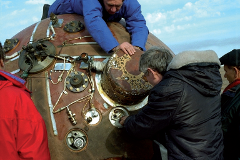 Hardware features: The BIOPAN facility is installed on the external surface of the Foton descent capsule protruding from the thermal blanket that envelops the satellite. It has a motor-driven hinged lid, which opens 180° in orbit to expose the experiment samples to the harsh space environment. The lid is software controlled to allow its automatic closure when the facility temperature goes out of operative range. For re-entry, the closed facility is protected with an ablative heat shield.
Hardware features: The BIOPAN facility is installed on the external surface of the Foton descent capsule protruding from the thermal blanket that envelops the satellite. It has a motor-driven hinged lid, which opens 180° in orbit to expose the experiment samples to the harsh space environment. The lid is software controlled to allow its automatic closure when the facility temperature goes out of operative range. For re-entry, the closed facility is protected with an ablative heat shield.
The facility is equipped with thermometers, UV sensors, a radiometer, a pressure sensor and an active radiation dosimeter. If controlled, the temperature can be stabilized between 5°C and 25°C. If uncontrolled, the temperature can fluctuate from less than -35°C to more than +30°C BIOPAN can also be flown in a mixed mode with one set of experiments being thermally controlled, and another not. Data acquired by the sensors is stored by BIOPAN throughout the mission and can be accessed after flight.
The BIOPAN electronics consists of the following units: signal acquisitionboard, microcontroller board with its flight software, memory board and EGSE.